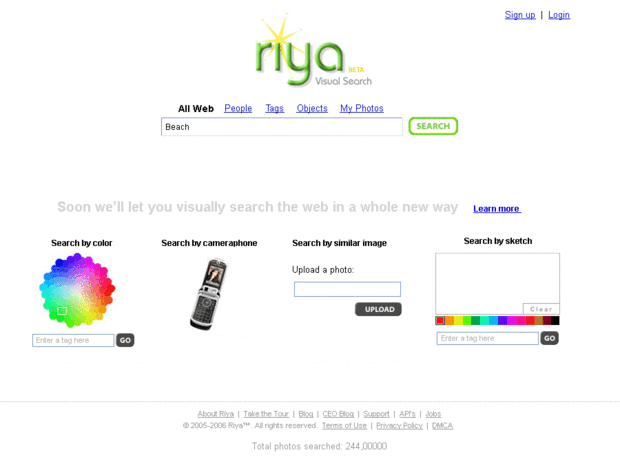50 million blogs and doubling in size every six months.
David Sifry has updated his State of the Blogosphere profile using current data from Technorati.
Essential reading.

50 million blogs and doubling in size every six months.
David Sifry has updated his State of the Blogosphere profile using current data from Technorati.
Essential reading.
Over the past 20+ years, I’ve seen a lot of communications plans. And I have marvelled at how often the authors of these plans have been unable to discern the difference between goals and objectives or strategies and tactics.
 In a recent episode of Inside PR, Chris Clarke asked asked listeners if they could explain the difference between communication goals and communication tactics.
In a recent episode of Inside PR, Chris Clarke asked asked listeners if they could explain the difference between communication goals and communication tactics.
 Shel Holtz provided an answer that linked strategies and tactics to goals and objectives. I found his explanation to be one of the most useful I have ever heard. Simple clear and concise.
Shel Holtz provided an answer that linked strategies and tactics to goals and objectives. I found his explanation to be one of the most useful I have ever heard. Simple clear and concise.
Of course, because it was an audio comment, you had to hear it. And because podcasts aren’t as readily searchable as blogs, I’ve decided to write down the essence of Shel’s explanation so that I, the people I work with and other practitioners can refer to it in future.
Shel recalled a presentation by Wilma Matthews, the Co-Author of On Deadline: Managing Media Relations. In her presentation, Wilma described a four step strategic planning model:
Wilma used the example of World War II in order to illustrate the application of these concepts.
In summary:
Makes sense to me. What do you think?
 A blog I like: Ed Lee’s Blogging Me Blogging You
A blog I like: Ed Lee’s Blogging Me Blogging You
Things I like:
1) Ed’s brighter than the average person and his posts show it. Always insightful.
2) Ed Tracksback and he comments. He engages in the conversation not just on his own blog but on others. He understands social media.
3) Ed brings a trans-Atlantic perspective to public relations. He reflects on his experience both in the UK and Canada. Just enough difference of perspective. Not the same old same old view of the pack.
Tip: Ed, the embedded video is great. Please include pictures with all your posts. The right pictures draw attention, enhance the appearance of the page and reinforce the headline.
 When PR types boast that social media belongs to PR because we understand conversation better than advertising, ask why it was an advertising agency that did this first.
When PR types boast that social media belongs to PR because we understand conversation better than advertising, ask why it was an advertising agency that did this first.
Thanks to Shel Holtz for pointing to this.
A video interview in which Chris Messina talks about BarCamp, WineCamp, CaseCamp and the spirit of sharing and collaboration. A bright, articulate guy providing information without pretence or ego. Nice.
 3 ways to increase search engine traffic
3 ways to increase search engine traffic
Stop. Don’t run away. This is not about gaming google. Nick Wilson offers some practical tips for increasing traffic to your blog: better copy, making it easy for people to link to you, and by networking.
In the wake of a Utah court decision against CleanFlicks’, which was making copies of movies to delete objectionable language, Jeff Jarvis reflects on copyright and creators’ rights.
Dell has redesigned their home page. In doing so, they’ve missed a great chance to make their customers feel that they are recognized as individuals.
Now, I’m not a Dell-basher. In fact, I’ve been a fan since founding Thornley Fallis in 1995. Over the years, we have standardized on Dell equipment. With the exception of a couple Apple systems, every computer and every server we own is a Dell product.
However, I have been frustrated by my inability to configure computers the way I want them once I’ve entered the Small Business channel on the Dell website. From time to time, the features I want on a particular system are only offered on the “Home and Home Office” channel. In order to find the system I want, I’m forced to search and compare across channels.

Yes, Dell has redesigned their Home Page. And guess what. They’re continuing to force customers to fit themselves into segments.
In a post on Dell one2one discussing the decision, Manisha Mehta, Dell’s Director – Global e-Commerce, says:
The previous version of the Dell.com home page forced you to pick what type of user you were and guided you within that segment. Products became secondary. Many users have provided feedback that they preferred to navigate by products. We made some changes, so you can now navigate by products initially, but we still ask you to identify what ‘segment’ you best represent.
Why? Just show me all the products you offer and let me decide . . .
Seems like a fairly easy thing to do… Can’t be that hard, right?
Unfortunately, it is a bit more complicated than just changing links. When you call Dell on the phone we have specific phone numbers depending on your customer type. This way we can offer you the right product, the best solutions & accessories, and the proper warranty/services coverage for your system.
The good news in this post is the confirmation that I am not alone in my dislike of the Dell customer segmentation system.
The bad news is that Dell seems determined to ignore this feedback.
In his blog post, Manisha acknowledges that Dell’s customers have told Dell that its segmentation scheme is not working for them. Unfortunately, Dell’s response insists that, “This way we can offer you the right product, the best solutions & accessories and the proper warranty/services coverage for your system.”
This type of thinking tells me that Dell has lost its understanding of what attracted me and (I’m sure) many others in the first place: the promise of customization by me to meet my needs. If I wanted a system that was pre-packaged by a manufacturer, I’d buy it at Best Buy.
Worse, the rationale for maintaining the segmentation seems to be connected to Dell’s beleaguered telephone support system.
I live in Canada, a small market. But still, I have in my Contacts four different Dell support numbers to which I’ve been directed on different calls. And I can never understand why I am shuffled around.
Companies will make mistakes. They will struggle with growth. They will also face the challenge of cost control. But they must learn from their mistakes.
Dell, I hope that you know how important it is to re-establish that special experience that once was had by selecting and owning a Dell computer.
Munjal Shah has posted some screen shots of Riya 2.0.

Munjal’s vision is for Riya 2.0 to be a
web-wide (public) visual search engine that uses face and image similarity to search the web. We are calling this new kind of public web search: Visual Search. Why? Because you will be able to search by clicking on / submitting a photo instead of having to type in text.
The screen shots suggest that Riya will, in fact, enable searches both by image and by text.
Munjal’s post today indicates that face similarity and image similarity will not be turned on at the outset. This is the the crunch capability. We’ll have to wait and see how this works in order to know whether Munjal can fully realize his vision.
Good luck Munjal. I for one am looking forward to using Riya 2.0.
Thank you Zoey. Although I don’t like to talk about myself, your link has given me a reason to break through my writer’s block (At least, I hope I can break it.)
So, here are Zoey’s questions and my answers:
When did you first start blogging and why?
My first blogging experience was on MSN Spaces in early 2005. I played around with a blog that I made available only to the people on my MSN Messenger contact list. Eventually, I decided I needed a more serious blogging platform. After experimenting with several platforms, including WordPress, TypePad and Movable Type, I settled on WordPress as the most flexible and user friendly. I launched the current ProPR blog on November 16, 2005.
I said in my first post:
Through this blog, I hope to have a voice in the discussion surrounding new developments in public relations, communications and marketing.
At my firm, we encourage people to develop to their maximum potential.
Thought leadership is an important goal for all professionals. With this blog, I hope to stimulate others to think about these issues and advance their own thinking.
This is still a pretty good description of why I am blogging.
What don’t you talk about?
I try not to stray off topic on this blog, which is focused on public relations best practices, the development of PR practitioners and what we can do to build the ideal public relations consulting firm. That means that I pretty much don’t talk about things that would be of interest to 99.9% of the population.
Are you and your blogging persona the same person?

I think my blogging persona is a lot less intense than I am in real life. Blogging is a chance to reflect on what’s important, what’s going on and what to do about it. It is also relaxing. Those who work with me would probably say that I am anything but relaxed.
How do you use blogging to build friendships?
I am constantly impressed with how blogging has enabled me to find people from around the world whose thoughts and opinions interest me and stimulate my own thinking. I try to comment on their blogs and Trackback from my own blog to some of their posts. I hope that over time they see me as part of their community in the same way as I think of them as part of my community.
But like many other bloggers, I seek out those who I have met online and try to meet them in the real world. Because there is still no substitute for eye contact and body language to truly get to know someone. And through this, I’ve met many bloggers who I like and whose company I enjoy. People like Shel Holtz, Shel Israel, David Jones (but we really knew one another before blogging,) Colin McKay, Ed Lee, Donna Papacosta, Chris Clarke, Josh Hallett. And I add to this list whenever I can.
I’m tagging… Terry Fallis. Terry’s really a podcaster. But he has a blog platform for Inside PR. And I’d like him to address these questions on the Inside PR Podcast. And the PR Girlz. Cause I think their answers to these questions will be a lot more interesting than mine were.
 I’ve been blogging for almost a year. But I’ve been like the driver of a car who has never looked under the hood. I don’t understand the technology that makes my blog work.
I’ve been blogging for almost a year. But I’ve been like the driver of a car who has never looked under the hood. I don’t understand the technology that makes my blog work.
Now, I don’t think it is necessary for every blogger to know how to write code. But I’ve felt the need to understand the essentials of the platform my blog is built on. In much the same way as I want to understand the fundamentals of my car’s engine – even if I rely on a mechanic to service it.
So, today I spent the afternoon following the tutorials on a great site, HTML Source. This site provides a practical, easy to follow introduction to html, CSS, JavaScript and other tools needed to develop websites.  Its author, Ross Shannon, is a 22 year old PhD student at University College Dublin.
Its author, Ross Shannon, is a 22 year old PhD student at University College Dublin.
I completed the first tutorial and at the end of it feel that I now understand basic html. I’m not pretending that I can begin to code my own site. But I now know how the basics are put together and I can make some simple edits and additions to my site using Notepad. In other words, I understand what’s under the hood and I can change the oil!
And all of this as a result of the kindness of a young computer wiz five time zones away. Thank you Ross. Your site has enabled me to do something I’ve wanted to do for years – gain a basic understanding of html.
 I’ve just returned from my vacation and I’m about to begin blogging after an absence of almost two weeks.
I’ve just returned from my vacation and I’m about to begin blogging after an absence of almost two weeks.
But what to write? I’m having a hard time getting back into the blogging state of mind.
I frequently tell new bloggers or those considering starting that they should not over-think their first posts. I tell them that the biggest mistake they could make would be to try to write something profound or truly memorable right off the bat. If they do, they could join the ranks of those who have been walking around with the “great American novel” locked in their brains for years. They never get it written down – good or bad.
And now I’m having the problem. I’m searching for something with real meaning. And I don’t have it.
So, a question to any bloggers who read this: Have you had this problem? How have you gotten past the short term block and back into the blogging routine?
Thanks for the picture to mjutabor.